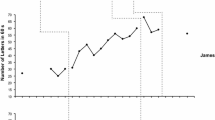Abstract
The purpose of this study was to evaluate the effect of two handwriting approaches, D’Nealian and Sunform, on kindergartners’ letter formations. Forty-one participants received D’Nealian handwriting instruction as the control group; 133 kindergartners were instructed in Sunform as the experimental approach. Pre-post tests at the beginning and end of school year asked kindergarten students to write the letters of the alphabet from memory. The letter formations were scored on a 4-point rubric for directionality and integration. The results showed the Sunform group had significantly higher scores on all but three letters of the alphabet. The D’Nealian students had considerably lower scores on missing or extra strokes, distortions and open letters. The findings of this study support the value of using an integrated, meaningful curriculum that appeals to young children and that supports motor development by requiring students to cross the midline to form counter-clockwise circles and diagonal lines. Implications for future research are included.
Similar content being viewed by others
References
Adams, M. J. (1990). Beginning to read, thinking and learning about print. Cambridge, MA: MIT Press.
Asher, A. V. (2006). Handwriting instruction in elementary schools. The American Journal of Occupational Therapy, 60(4), 461–471.
Bear, D. R., Invernizzi, M., Templeton, S., & Johnston, F. (2008). Words their way. Upper Saddle River, NJ: Pearson.
Bennett, J. (2009). The curse of cursive. Newsweek, February 23, 2009.
Graham, S. (1986). The reliability, validity, and utility of three handwriting measurement procedures. Journal of Educational Research, 79, 373–380.
Graham, S., Berninger, V., Abbott, R., Abbott, S., & Whitaker, D. (1997). Role of mechanics in composing of elementary school students: A new methodological approach. Journal of Educational Psychology, 89, 170–182.
Graham, S., Harris, K. R., & Fink, B. (2000). Is handwriting causally related to learning to write? Treatment of handwriting problems in beginning writers. Journal of Educational Psychology, 92(4), 620–633.
Graham, S., Harris, K. R., Mason, L., Fink-Chorzempa, B., Moran, S., & Saddler, B. (2008). How do primary grade teachers teach handwriting? A national survey. Reading and Writing: An Interdisciplinary Journal, 21(1–2), 49–69.
Graham, S., Struck, M., Santoro, J., & Berninger, V. W. (2006). Dimensions of good and poor handwriting legibility in first and second graders: Motor programs, visual-spatial arrangement, and letter formation parameter setting. Developmental Neuropsychology, 29(1), 43–60.
Graham, S., Weintraub, N., & Berninger, V. (2001). Which manuscript letters do primary grade children write legibly? Journal of Educational Psychology, 39(3), 488–497.
Hannaford, C. (1995). Smart moves. Arlington, VA: Great Ocean Publishers.
Marr, D., Windsor, M. M., & Cermak, S. (2001). Handwriting readiness: Locatives and visuomotor skills in the kindergarten year. Early Childhood Research and Practice, 3(1). Retrieved March 22, 2004 from http://ecrp.uiuc.edu/v3n1/marr.html.
Massengill Shaw, D., & Sundberg, M. L. (2008). How a neurologically integrated approach which teaches sound-symbol correspondence and legible letter formations impacts at-risk first graders. Journal of At-Risk Issues, 14(1), 13–21.
Massengill, D., Sundberg, M. L., & Stewart, A. (2006). A unique, neurologically integrated approach designed to teach letter sounds and formations. Reading Improvement, 43(3), 111–128.
Nelson, R. H., & Trafford, C. H. (2007). Evidence based handwriting instruction self evaluation guide. Peterson Directed Handwriting. Retrieved September 3, 2009 from www.peterson-handwriting.com.
Pressler, M. W. (2006, October 12). Except for a few defenders, cursive all but written off. Lawrence Journal World, p. 3A.
Scott Foresman & Company. (1978). D’Nealian manuscript alphabet. Chicago, IL: Author.
Sheffield, B. (1996). Handwriting: A neglected cornerstone of literacy. Annals of Dyslexia, 46, 21–35.
Suddath, C. (2009). Mourning the death of handwriting. Time, August 3, 2009. Retrieved August 3, 2009 from www.time.com.
Sundberg, M. L. (1994). Sunform alphabet system manual. Lake Bluff, IL: Sundberg Learning Systems, Inc.
Sylwester, R. (1995). A celebration of neurons: An educator’s guide to the human brain. Alexandria, VA: Association for Supervision and Curriculum Development.
Vander Hart, N., Fitzpatrick, P., & Cortesa, C. (2009). In-depth analysis of handwriting curriculum and instruction in four kindergarten classrooms. Reading and Writing (online edition) April 20, 2009. Retrieved September 30, 2009.
Zaner-Bloser (2004). How legible handwriting enhances the writing process and assessment. Retrieved March 22, 2004 from www.zaner-bloser.com.
Acknowledgments
The author wishes to thank Mary Lou Sundberg and her team of assessors for their assistance.
Author information
Authors and Affiliations
Corresponding author
Rights and permissions
About this article
Cite this article
Shaw, D.M. The Effect of Two Handwriting Approaches, D’Nealian and Sunform, on Kindergartners’ Letter Formations. Early Childhood Educ J 39, 125–132 (2011). https://doi.org/10.1007/s10643-011-0444-2
Published:
Issue Date:
DOI: https://doi.org/10.1007/s10643-011-0444-2




